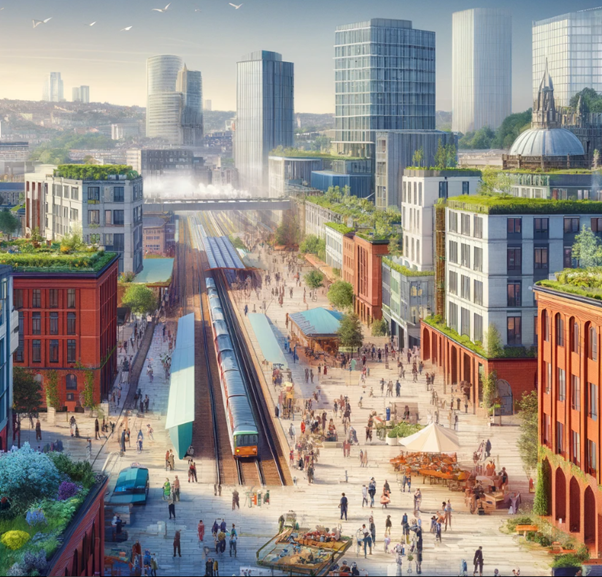Keyman Blog

🏗️ New Labour Reforms: A Game-Changer for Construction Jobs in the UK? The UK construction sector is standing on the edge of major transformation—and it’s Labour that's holding the blueprint. With bold housing targets, sweeping planning reforms, and a renewed focus on apprenticeships, Labour’s new policies aren’t just reshuffling the deck—they’re promising a whole new playing field. Could this be the biggest shake-up the industry has seen in decades? 🏠 Labour’s Big Build: 1.5 Million Homes Labour’s headline pledge? Build 1.5 million homes over the next five years. That’s around 300,000 homes a year—a figure not hit since the 1970s. And it’s not just more of the same. Labour wants to resurrect mandatory housing targets, overhaul planning laws, and launch a wave of brand-new towns—think 20,000 to 60,000 homes each, with transport links, schools, jobs, and green space built in. “We’re going to restore mandatory housing targets and get Britain building again,” said Deputy Leader Angela Rayner. At least 40% of homes in these towns will be affordable or social housing, a much-needed boost as housing demand continues to outstrip supply. Where Are the Workers Coming From? Here’s the catch: we don’t currently have enough builders to meet that ambition. The CITB estimates the industry needs 225,000 new workers by 2027. Labour’s answer? Double the number of apprenticeships by 2026, especially in trades like bricklaying, plumbing, and carpentry. “We must invest in British skills to meet British housing needs,” said Housing Minister Matthew Pennycook. “We can’t keep relying on overseas labour to hit our targets.” This homegrown approach could be a lifeline for a sector that’s been struggling to fill roles since Brexit and the pandemic. Expect a surge in local training programmes, college partnerships, and construction firms getting proactive with recruitment. 🌱 Green Construction = Green Jobs Labour’s plan doesn’t stop at bricks and mortar. They’re betting big on green infrastructure, with projects like the Liverpool Bay Carbon Capture and Storage (CCS) scheme leading the way. Not only will this cut emissions, but it’s also expected to create thousands of construction and engineering jobs—especially in the North. And then there’s ‘Great British Energy’, a new publicly owned renewables company, which will boost the demand for skills in solar, wind, and retrofitting homes. “The green economy is a jobs economy,” said Labour Leader Keir Starmer. “We want the UK to lead in both climate action and employment creation.” 💬 What’s the Industry Saying? The reaction from the construction sector? Cautious optimism. The National Federation of Builders welcomed Labour’s commitment to growth and reform, noting that clear targets and a stable policy outlook are exactly what the industry needs. Even large developers are chiming in. “If we all stick to the plan, 1.5 million homes is achievable,” said David Thomas, CEO of Barratt Redrow. “But we’ve got to fix the planning system and the skills gap.” Still, some concerns linger. The Federation of Master Builders (FMB) has warned that unless local councils are given resources and support, Labour’s lofty goals could stall at the planning desk. 📊 Construction by the Numbers The good news? Things are already moving. According to the ONS, construction output in February 2025 rose by 0.4%, following a small dip in January. Growth came from both new work and repairs—early signs that confidence is returning to the market. But with inflation still high and material costs unpredictable, firms will be watching carefully to see how Labour manages the financial pressures on builders. ✍️ Final Thoughts: Boom or Bust? Labour’s reforms promise a new era for UK construction. The goals are bold, the plans ambitious, and the potential impact—massive. If delivered well, this could usher in hundreds of thousands of new jobs, especially for young people and tradespeople looking to build a future. But the road to 1.5 million homes isn’t paved just yet. It will take collaboration, investment, and—most importantly—speed. If the government and industry can align, we’re not just talking about more houses. We’re talking about a real jobs revolution in construction.

The construction sector has one of the highest suicide rates of any industry. According to the Office for National Statistics (ONS), male construction workers are three times more likely to die by suicide than the national average for men in the UK. In fact, around two construction workers in the UK take their own lives every day. This stark reality underscores the importance of fostering a supportive and open culture where men feel comfortable discussing their struggles. Why Are Construction Workers at Risk? There are several factors contributing to the mental health crisis in construction: Job insecurity: Many construction roles are contract-based, leading to financial instability. Long hours: Extended working hours and demanding physical labour leave little time for rest or personal life. Workplace culture: Traditional notions of masculinity can discourage men from seeking help or expressing vulnerability. Isolation: Frequent travel for work can strain relationships with family and friends. Signs Someone May Be Struggling Recognising the signs of mental health struggles is critical. These may include: Changes in behaviour or mood Increased absenteeism Lack of motivation or productivity Withdrawal from colleagues and loved ones A Call to Action: Supporting Each Other Employers and colleagues can play a pivotal role in creating a mentally healthy workplace. Here are a few steps that can make a difference: Start conversations: Make mental health a regular topic in team meetings. Provide training: Equip managers and team leaders to recognise signs of mental distress. Offer resources : Promote access to Employee Assistance Programmes (EAPs) and helplines. Normalise help-seeking: Share stories of recovery to break the stigma around mental health. Organisations Providing Help If you or someone you know is struggling, reach out to these resources: Samaritans: Call 116 123 or email jo@samaritans.org for 24/7 support. Mind: Call 0300 123 3393 or text 86463. Visit www.mind.org.uk for guidance and support. Construction Industry Helpline: Call 0345 605 1956 or visit www.lighthouseclub.org for advice tailored to construction workers. CALM (Campaign Against Living Miserably): Call 0800 58 58 58 or visit www.thecalmzone.net for support for men. Together, We Can Build a Better Future Mental health is as vital as physical safety on-site. By addressing the challenges head-on and offering support, the construction industry can pave the way for a healthier, more resilient workforce. This November, let’s commit to breaking the silence and ensuring every worker knows they are not alone.

In recent years, digital transformation has taken the UK construction industry by storm. Leveraging cutting-edge tools and platforms, the sector is experiencing unprecedented advancements in project management, design, and overall construction processes. This digital revolution is not only enhancing efficiency but also significantly improving project outcomes. Let's delve into how digital tools are reshaping the construction landscape in the UK. Revolutionising Project Management Digital transformation is fundamentally altering how projects are managed in the construction industry. Traditional methods, often characterised by manual processes and paperwork, are being replaced by sophisticated project management software. These tools facilitate real-time collaboration, streamline workflows, and provide greater visibility into project progress. Building Information Modelling (BIM) is one of the most influential tools in this regard. BIM allows for the creation of detailed 3D models that integrate all aspects of a construction project. According to a report by the UK Government, the adoption of BIM has led to a 33% reduction in project costs and a 50% decrease in project delivery times. John Smith, a project manager at a leading UK construction firm, states, "BIM has transformed the way we plan and execute our projects. The level of detail and coordination it offers is unparalleled." Additionally, cloud-based project management platforms like Procore and Autodesk Construction Cloud are enabling teams to access project data from anywhere, at any time. This flexibility ensures that all stakeholders are on the same page, reducing delays and improving communication. Enhancing Design Processes The design phase of construction projects is also benefiting immensely from digital tools. Advanced software solutions are allowing architects and engineers to create more accurate and innovative designs. Virtual Reality (VR) and Augmented Reality (AR) are playing a pivotal role in this transformation. These technologies provide immersive visualisations of projects before they are built, enabling better decision-making and stakeholder engagement. For instance, VR can be used to conduct virtual walkthroughs of a building, helping clients and project teams to identify potential issues early in the design phase. Generative design is another groundbreaking technology revolutionising the design process. This approach uses algorithms to generate a multitude of design options based on specific parameters and constraints. As a result, architects can explore a wider range of possibilities and optimise designs for efficiency and sustainability. A study by the Royal Institute of British Architects (RIBA) found that generative design can reduce material usage by up to 20%, contributing to more sustainable construction practices. Streamlining Construction Processes On-site construction processes are being streamlined through the use of digital tools, leading to improved productivity and safety. Drones are becoming increasingly common on construction sites, used for tasks such as site surveys, inspections, and progress monitoring. Drones can capture high-resolution images and videos, providing project managers with detailed insights into site conditions. This technology not only speeds up data collection but also reduces the risk to workers by minimising the need for manual inspections in hazardous areas. Robotics and automation are also making significant inroads into the construction industry. Robots are being used for tasks such as bricklaying, concrete pouring, and demolition. These machines can work tirelessly and with high precision, leading to faster project completion and reduced labour costs. According to a report by the Chartered Institute of Building (CIOB), the use of robotics in construction could increase productivity by up to 25%. Furthermore, Internet of Things (IoT) devices are enhancing the connectivity and intelligence of construction sites. Sensors embedded in equipment and materials provide real-time data on various parameters, such as temperature, humidity, and equipment performance. This data enables predictive maintenance, reducing downtime and extending the lifespan of machinery. Conclusion The digital transformation of the UK construction industry is well underway, with digital tools and platforms revolutionising project management, design, and construction processes. By embracing technologies such as BIM, VR, generative design, drones, and IoT, the sector is becoming more efficient, innovative, and sustainable. As the industry continues to evolve, the adoption of these digital tools will be crucial for staying competitive and delivering high-quality projects. The future of construction in the UK looks promising, with technology paving the way for a more connected and efficient built environment. In the words of Sarah Johnson, a leading construction technology expert, "Digital transformation is not just about adopting new tools; it's about rethinking how we approach construction projects from start to finish. The possibilities are endless, and the benefits are profound." By staying ahead of the curve and embracing digital transformation, the UK construction industry is set to achieve new heights of success and sustainability.

As urban environments continue to expand, the need for sustainable building practices becomes ever more pressing. One innovative solution gaining popularity in the UK is green roofing. Not only do green roofs offer aesthetic appeal, but they also provide numerous environmental, economic, and social benefits. In this blog, we will explore these advantages and delve into the installation process of green roofs, supported by statistics and expert quotes. The Benefits of Green Roofs Environmental Benefits Improved Air Quality: Green roofs contribute to cleaner air by absorbing pollutants and carbon dioxide. According to a study by the University of Reading, a single square metre of green roof can capture up to 0.2 kg of particulate matter annually. Urban Heat Island Effect: Green roofs help mitigate the urban heat island effect by providing natural insulation. A report from the Greater London Authority highlights that green roofs can reduce ambient temperatures by up to 2°C during peak summer months. Biodiversity: Green roofs create habitats for various species, enhancing urban biodiversity. The Royal Horticultural Society notes that green roofs can support up to 86 different plant species, promoting a healthier ecosystem. Economic Benefits Energy Efficiency: Green roofs offer excellent insulation, reducing the need for heating in winter and cooling in summer. The Green Roof Centre estimates that buildings with green roofs can see energy savings of up to 15%. Increased Property Value: Properties with green roofs are often valued higher due to their sustainability features and aesthetic appeal. Savills, a leading real estate advisor, suggests that green roofs can increase property values by approximately 7%. Stormwater Management: Green roofs absorb rainwater, reducing runoff and the burden on drainage systems. This not only prevents flooding but also lowers the cost of stormwater infrastructure. According to the Environment Agency, green roofs can retain up to 70-90% of rainfall during the summer. Social Benefits Wellbeing: Green spaces have been shown to improve mental health and wellbeing. A study by the University of Exeter found that people living near green spaces report lower levels of stress and higher life satisfaction. Aesthetic and Recreational Value: Green roofs provide visually appealing spaces that can be used for leisure and recreation. They transform otherwise unused rooftops into valuable community assets. Installation Process of Green Roofs Assessment and Planning Structural Evaluation: Before installation, a structural engineer must assess whether the building can support the additional weight of a green roof. This evaluation ensures safety and longevity. Design and Selection: The type of green roof (extensive, semi-intensive, or intensive) must be chosen based on the building's structure and intended use. Extensive roofs are lightweight and low-maintenance, while intensive roofs are heavier and can support more complex vegetation. Installation Steps Waterproofing Layer: A high-quality waterproof membrane is essential to prevent water leakage and protect the building structure. This layer must be thoroughly tested before proceeding. Root Barrier: To prevent plant roots from penetrating the waterproof membrane, a root barrier is installed. This layer is crucial for maintaining the integrity of the roof. Drainage Layer: Proper drainage is vital for green roofs. A drainage layer ensures that excess water is efficiently removed, preventing waterlogging and root rot. Growing Medium: A specially formulated soil mix is applied, tailored to support the chosen vegetation. This medium must provide adequate nutrients, drainage, and stability. Vegetation: Finally, the selected plants are installed. For extensive roofs, hardy, low-maintenance species like sedums are popular. Intensive roofs can support a wider variety of plants, including shrubs and small trees. Expert Insights Dr. Caroline Nash, an urban ecology expert at the University of Birmingham, remarks, "Green roofs are a powerful tool in our efforts to create sustainable cities. They not only provide environmental benefits but also enhance urban resilience and quality of life." According to Ben Green, a senior architect at Foster + Partners, "Incorporating green roofs into building designs is becoming increasingly common. Clients are recognising the long-term benefits, both economically and environmentally, of investing in green infrastructure." Conclusion Green roofs present a multifaceted solution to many of the challenges faced by urban environments today. From improving air quality and biodiversity to reducing energy costs and enhancing wellbeing, their benefits are substantial. As awareness and technology advance, the adoption of green roofing solutions in the UK is set to rise, contributing to more sustainable and liveable cities.

Urban planning and infrastructure development in the UK are at a pivotal juncture. As cities continue to grow and evolve, the demands on urban spaces and services are increasingly complex and challenging. The focus is now shifting towards creating sustainable, resilient, and adaptive urban environments that can meet the needs of their diverse populations. This blog explores the latest trends, statistics, and expert opinions in the field of urban planning and infrastructure development in the UK. Embracing Sustainability and Resilience One of the core aspects of modern urban planning is sustainability. The UK government's commitment to achieving net-zero carbon emissions by 2050 is driving innovation in sustainable urban design. Cities across the UK are aiming to reduce their environmental impact through a variety of measures, from increasing green spaces to promoting public transport and cycling. A study by the Urban Transport Group highlights that public transport use in major UK cities has the potential to save 400,000 tonnes of carbon emissions annually. This statistic underscores the significance of integrating sustainable transport solutions into urban planning strategies. The Rise of Smart Cities Smart city initiatives are transforming urban living. Technologies such as IoT (Internet of Things) and AI (Artificial Intelligence) are being leveraged to improve everything from traffic management to energy use and public safety. For instance, cities like Manchester and Glasgow are leading the way with smart city projects aimed at enhancing connectivity and liveability. "The integration of digital technology into urban planning is not just a trend; it's a complete overhaul of how we conceptualize living spaces," says Dr. Helen Wright, a leading urban planner based in London. Dr. Wright’s observation reflects a broader shift towards data-driven approaches in urban development. Challenges and Opportunities While the advancements are promising, they come with their own set of challenges. Urban inequality and housing affordability remain pressing issues. The disparities in living conditions and access to services are stark, necessitating thoughtful interventions from urban planners and policymakers. Moreover, the COVID-19 pandemic has altered the landscape of urban planning. The rise in remote working has led to a decreased need for office space, prompting a rethink of city centre land use. "The pandemic has taught us the importance of flexible urban spaces that can adapt to changing human behaviours," notes urban sociologist Prof. James Kearney. Infrastructure Development: Keeping Pace with Innovation Infrastructure development is critical in supporting these urban transformations. The UK's recent Infrastructure Delivery Plan 2021 highlights an investment of £100 billion in infrastructure to stimulate economic growth and support a green recovery post-pandemic. Significant projects include the expansion of high-speed rail networks, such as HS2, and upgrades to national broadband networks to support digital connectivity. These developments are not just about economic growth but are also crucial in shaping more connected and accessible cities. Conclusion The future of urban planning and infrastructure in the UK is dynamic and fraught with both opportunities and challenges. As urban planner Dr. Wright aptly puts it, "We are not just building cities, we are shaping ecosystems for future generations." The responsibility is great, and so is the potential for transformative change. Urban planning must continue to evolve, integrating both technological innovations and fundamental human needs to create spaces that are not only efficient but also inclusive and sustainable.

Modular construction is steadily rising in popularity within the UK, heralding a new era of efficiency and cost-effectiveness in the construction industry. This innovative approach, which involves fabricating building components in a factory before assembling them on-site, offers numerous advantages over traditional construction methods. The Rise of Modular Construction The UK construction industry has long been plagued by inefficiencies, delays, and cost overruns. Modular construction addresses these issues by allowing for simultaneous site preparation and building fabrication, significantly reducing project timelines. According to a report by the UK Parliament, the modular construction market is expected to grow by 6.3% annually, reaching a value of £12 billion by 2025. One notable example of this growth is the £2.5 billion modular housing scheme announced by Homes England, aimed at delivering 25,000 new homes by 2026. This ambitious project underscores the government's commitment to modernising the housing sector and addressing the national housing shortage. Efficiency and Speed Modular construction can reduce project timelines by up to 50%, a significant improvement over traditional methods. The Construction Industry Training Board (CITB) reports that modular projects typically achieve an 80% reduction in on-site labour, thanks to the precision and predictability of factory settings. This efficiency is particularly advantageous in urban areas where minimising disruption is crucial. A case in point is the George Street development in Croydon, London, where two high-rise towers were completed 40% faster than if they had been built using conventional techniques. This project demonstrates how modular construction can deliver large-scale developments swiftly and with minimal disruption to the surrounding area. Cost-Effectiveness The cost savings associated with modular construction are also noteworthy. The CITB estimates that modular construction can reduce costs by up to 20% due to economies of scale and reduced waste. The controlled environment of a factory allows for better resource management and quality control, leading to fewer errors and less rework. In a study conducted by the Modular Building Institute, 75% of developers reported lower costs and higher profitability when using modular construction. This cost-effectiveness is particularly appealing in a sector often beset by budget overruns and financial uncertainty. Quality and Sustainability The precision of factory fabrication ensures high-quality finishes and robust construction standards. Modules are built to withstand transportation and assembly, often exceeding the durability of traditionally constructed buildings. Moreover, the modular approach aligns with the UK’s sustainability goals. Off-site construction generates up to 90% less waste, and the controlled environment allows for better energy efficiency and material use. Tim Hall, CEO of modular construction firm InHouse, highlights the sustainability benefits: "Modular construction not only speeds up the building process but also significantly reduces waste and carbon emissions. It's a win-win for the industry and the environment." Future Prospects As the UK grapples with a housing crisis and the need for more efficient building practices, modular construction offers a promising solution. The government's support, coupled with the industry's growing acceptance, points to a bright future for this construction method. The Construction Leadership Council's Roadmap to Recovery emphasises the role of modular construction in building back better post-COVID-19, with an emphasis on resilience and sustainability. Conclusion The future of modular construction in the UK looks promising, driven by its potential to revolutionise the construction industry with greater efficiency, cost-effectiveness, and sustainability. As the sector continues to evolve, modular construction is set to play a pivotal role in meeting the UK's housing needs and advancing the construction industry's overall progress. By embracing this innovative approach, the UK can build faster, smarter, and more sustainably, paving the way for a more resilient and efficient construction sector.

Mental Health Awareness Week, held annually in the UK, shines a vital spotlight on mental health issues, encouraging us to foster a more open dialogue about mental wellbeing. This year, from the 13th to the 19th of May, the theme focuses on anxiety, a condition that affects millions across the nation. Understanding the Impact Anxiety disorders are among the most common mental health conditions in the UK. According to the Mental Health Foundation, an estimated 8.2 million people in the UK experience anxiety each year. Despite its prevalence, anxiety is often misunderstood and stigmatised, making awareness initiatives crucial. "We need to break the silence surrounding mental health issues and create a society where everyone feels safe to talk about their mental wellbeing," says Mark Rowland, CEO of the Mental Health Foundation. The Statistics One in four people in the UK will experience a mental health problem each year. One in six people report experiencing a common mental health problem (like anxiety and depression) in any given week in England. According to the Office for National Statistics, 19% of adults in Great Britain experienced some form of depression during the COVID-19 pandemic, double the pre-pandemic figures. Raising Awareness and Support Mental Health Awareness Week aims to reduce the stigma associated with mental health issues and provide support for those in need. The campaign encourages people to share their experiences and support each other. Various events, workshops, and online activities are organised to promote mental wellbeing and offer practical advice on managing anxiety. Personal Stories Sharing personal stories can have a profound impact on reducing stigma. Emily, a 29-year-old teacher from Manchester, shares her experience: "Living with anxiety has been a challenge, but speaking about it openly with friends and family has been incredibly liberating. Mental Health Awareness Week reminds us that we are not alone in our struggles." UK Helplines If you or someone you know is struggling with anxiety or other mental health issues, it’s crucial to seek help. Here are some UK-based helplines offering support: Samaritans: Available 24/7, Samaritans provide confidential support for people experiencing feelings of distress or despair. Call 116 123. Mind: This mental health charity offers information and advice. Call their Infoline at 0300 123 3393 or text 86463. Anxiety UK: Specialising in anxiety disorders, Anxiety UK offers support via their helpline at 03444 775 774. CALM (Campaign Against Living Miserably): Aimed at preventing male suicide, CALM offers support through their helpline at 0800 58 58 58. Shout: A 24/7 text service for anyone in crisis. Text 85258 to start a conversation with a trained volunteer. How You Can Help Mental Health Awareness Week encourages everyone to take part in raising awareness and supporting those affected by mental health issues. Here are a few ways you can get involved: Start a Conversation: Talking about mental health can help break the stigma. Share your own experiences and listen to others. Educate Yourself and Others: Learn more about anxiety and other mental health conditions. Use reliable sources and share this knowledge with your community. Participate in Events: Join local events or online workshops during Mental Health Awareness Week to show your support. Donate: Support mental health charities by donating or fundraising. Every contribution helps provide vital resources and support. Conclusion Mental Health Awareness Week is a pivotal time for the UK to come together and address the mental health crisis. By raising awareness, sharing experiences, and providing support, we can create a more compassionate and understanding society. Remember, it’s okay not to be okay, and help is always available. "The greatest weapon against stress is our ability to choose one thought over another." – William James For more information on Mental Health Awareness Week and how to get involved, visit the Mental Health Foundation website.

The construction industry in the UK has undergone significant transformations over the centuries, evolving from simple stone masonry to the use of advanced materials and technologies. This journey from historical techniques to modern advances not only showcases the ingenuity of human civilisation but also highlights the adaptive nature of construction practices to meet contemporary needs. Historical Techniques: A Foundation Built on Ingenuity Historically, British construction relied heavily on locally sourced materials, which shaped the architectural aesthetics and structural methodologies of the time. For instance, the use of timber in Tudor buildings or the iconic limestone in the construction of Oxford's historical university buildings are perfect examples of this era. These materials were not only chosen for their availability but also for their durability. A notable technique from the past is the "cob" construction, prevalent in South West England. This method involved using a mixture of earth, clay, and straw, hand-applied to create thick walls that provided excellent thermal mass, keeping buildings warm in winter and cool in summer. According to a heritage specialist, "Cob construction demonstrates a remarkable understanding of natural materials and their thermal properties, a principle that is surprisingly in tune with today's sustainable building practices." The Transition to Modern Construction The industrial revolution marked a pivotal shift in construction techniques. The introduction of Portland cement in the early 19th century revolutionised construction, paving the way for the development of concrete as a core material in building. This period also saw the advent of steel production, which significantly influenced the skyline with structures like the Shukhov Tower demonstrating the potential of steel in architectural design and construction. Modern construction in the UK now integrates a range of new materials and technologies. Innovations such as cross-laminated timber (CLT) and glass-fibre reinforced concrete (GFRC) have been pivotal. As noted by a contemporary architect, "The adoption of CLT in particular has allowed us to rethink how we design large, sustainable buildings, combining strength with sustainability." Statistical Insights into Construction Evolution Recent statistics highlight the rapid growth of sustainable materials in the UK construction sector. A report from 2022 indicates that the use of sustainable building materials has increased by 35% over the past five years. Moreover, the integration of technology has led to a 20% improvement in construction time and a 15% reduction in costs, thanks to advanced project management software and automation technologies. Challenges and Opportunities Despite the advances, the transition from traditional to modern techniques is not without challenges. Maintaining the architectural integrity of historic buildings while integrating modern amenities and ensuring compliance with current building regulations poses a unique set of challenges. Furthermore, the skill gap in traditional construction techniques is becoming evident, as noted by a leading construction historian: "There is a growing need to preserve these skills as they are an intrinsic part of our cultural heritage." Looking Forward The UK's construction industry continues to evolve, with a strong focus on sustainability and efficiency. The blend of historical techniques with modern advances offers a unique pathway towards innovative, sustainable, and efficient construction practices. As we move forward, the industry's challenge will be to balance these aspects while preserving the rich architectural heritage of the UK. By examining the past and embracing the future, the construction industry in the UK not only pays homage to its historical roots but also paves the way for a more sustainable and innovative future. This evolution, driven by both necessity and ingenuity, continues to shape the landscapes and skylines of the UK.

Asbestos, once a cornerstone material in the UK construction industry due to its insulation and fire-resistant properties, now represents a significant health hazard with a legacy of danger that continues to impact workers and homeowners alike. This article provides a detailed look at the history, current status, and future outlook of asbestos in UK construction, supplemented by key statistics and expert insights. The Historical Context of Asbestos In the UK, the use of asbestos peaked between the 1950s and late 1970s, predominantly within construction materials such as roofing, insulation, and floor tiles. It was hailed for its durability and protective qualities, particularly against heat and corrosion. However, by the late 20th century, the severe health risks associated with asbestos fibres became undeniable. Inhaling these fibres can lead to deadly diseases such as mesothelioma, asbestosis, and lung cancer, which often manifest decades after exposure. Current Statistics and Regulations Asbestos remains one of the leading occupational killers in the UK. According to the Health and Safety Executive (HSE), there are over 5,000 asbestos-related disease deaths per year, including around 2,500 from mesothelioma. Despite the ban on new uses of asbestos instituted in 1999, millions of buildings constructed before this year still contain asbestos materials. "The legacy of asbestos use is a ticking time bomb in many older buildings," explains Dr. Emily White, an environmental health expert. "It's not just an issue for those working in construction but also for those occupying these buildings, unaware of the invisible risk." Asbestos Management and Removal The Control of Asbestos Regulations 2012 is the current legal framework guiding how asbestos is handled during building work in the UK. These regulations require duty holders to manage the risk from asbestos by locating it within buildings, determining its condition, and assessing the risk of exposure. Timothy Blake, a seasoned asbestos removal specialist, comments, "The removal of asbestos must be handled with extreme care, following stringent safety protocols to ensure that fibres are not released into the air. It is a meticulous process, but absolutely essential for the safety of everyone involved." Challenges and Future Directions One of the ongoing challenges in managing asbestos risk is the training and education of construction professionals and workers. Many are unaware of or underestimate the risks associated with asbestos. Moreover, illegal and improper disposals continue to pose environmental and health risks. Looking to the future, innovation in detection and removal technologies holds promise. New methods, such as advanced imaging techniques and robotics, are being developed to improve the safety and efficiency of asbestos removal processes. Conclusion The UK construction industry's relationship with asbestos is a cautionary tale of innovation shadowed by unforeseen consequences. As we move forward, the focus must remain on managing existing risks, improving regulatory compliance, and ensuring that all construction and demolition workers are adequately trained in asbestos awareness and safety. The path forward is clear: vigilance, education, and innovation are key to resolving the asbestos crisis in UK construction. This comprehensive approach, underpinned by historical understanding and forward-looking innovation, highlights the need for continued commitment at all levels to eradicate the dangers of asbestos from UK buildings, safeguarding current and future generations.

Southern England is witnessing significant transformation through various regeneration initiatives that are revitalising urban areas, enhancing living conditions, and boosting local economies. These projects not only address the architectural and infrastructural needs but also aim to strengthen community ties and promote sustainable development. Here, we explore some of the key regeneration efforts in southern regions, their impacts, and the challenges encountered. The Bristol Temple Quarter One of the most impactful regeneration projects in the South is the Bristol Temple Quarter. This initiative aims to revamp and revitalise the area around the Bristol Temple Meads station, turning it into a vibrant new enterprise zone. The project seeks to create over 22,000 jobs and add an additional £1.6 billion a year to the local economy. The plan includes new homes, business spaces, and improved transport links to better integrate the city centre with its outskirts. "Temple Quarter is set to become a beacon of economic and social regeneration," says Marvin Rees, Mayor of Bristol. "It represents a significant step towards our vision of a connected, inclusive, and sustainable Bristol." Southampton’s Royal Pier Waterfront Southampton is also undergoing a major transformation with the Royal Pier Waterfront project. This ambitious plan aims to develop the city’s waterfront with new residential, retail, and leisure facilities. The project will rejuvenate the historic Royal Pier area, making it a focal point for both residents and tourists. The proposed development includes up to 730 new homes, a 250-room luxury hotel, and various cultural and leisure facilities, poised to reshape the city’s skyline and social fabric. Project spokesperson, Helen Lomas, comments, "The Royal Pier Waterfront project is about creating a destination that both respects Southampton’s rich maritime history and promises growth and prosperity for its future." Ebbsfleet Garden City, Kent In Kent, the development of Ebbsfleet Garden City stands out as a prime example of modern urban planning. This new community is being designed to provide up to 15,000 homes, supported by essential amenities including schools, shops, and leisure facilities, all set within a network of green spaces. Additionally, the project is focused on sustainability, with initiatives aimed at minimising carbon footprint and enhancing environmental quality. Ian Piper, CEO of Ebbsfleet Development Corporation, explains, "We are not just building homes; we are creating a template for future living, where sustainability and community are at the heart of development." Challenges Across the South Despite the enthusiasm surrounding these projects, they face myriad challenges such as environmental concerns, the preservation of historical sites, and local opposition to certain developments. Funding constraints and regulatory hurdles also pose significant challenges, especially in the post-Brexit and post-pandemic landscape. However, the outlook remains overwhelmingly positive. These regeneration projects are crucial for the economic revitalisation and social rejuvenation of Southern England. They offer new opportunities for investment and development, promising a brighter future for the regions' residents and businesses alike. Through these transformative projects, Southern England is setting a precedent for how regeneration can effectively blend history with modernity, fostering communities that are resilient, inclusive, and forward-looking.

